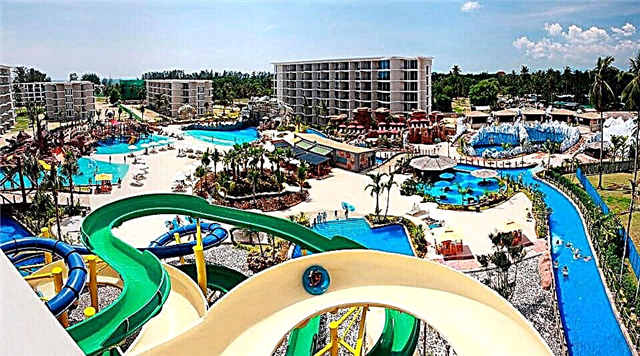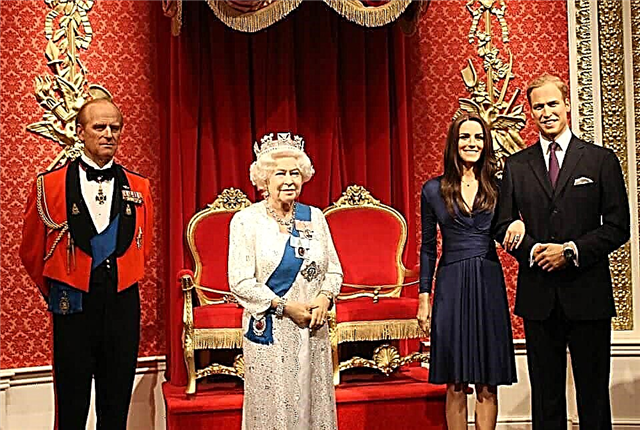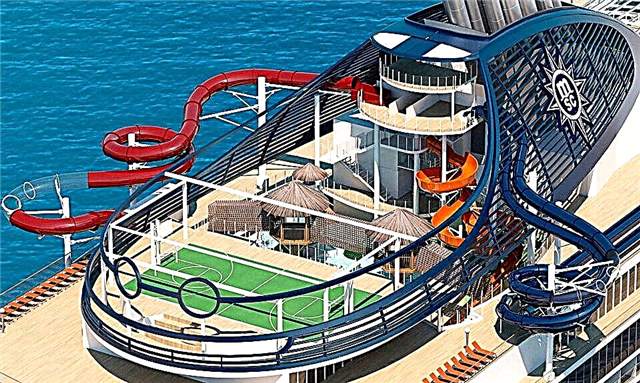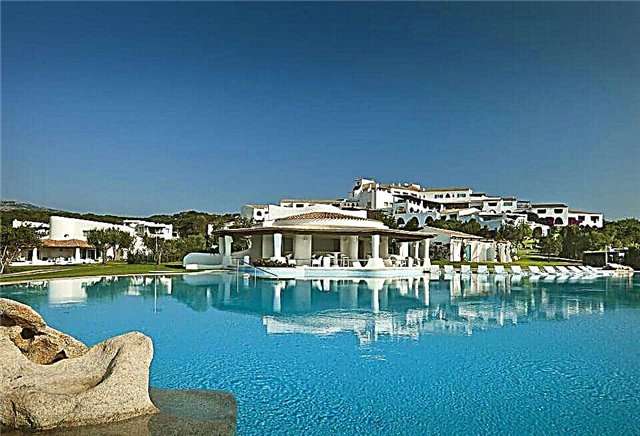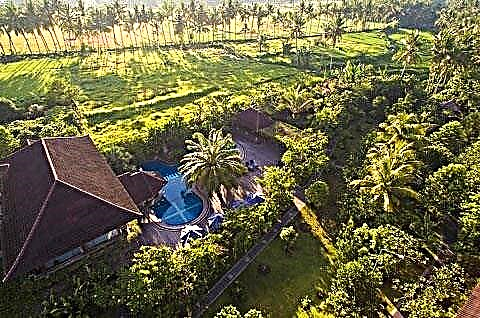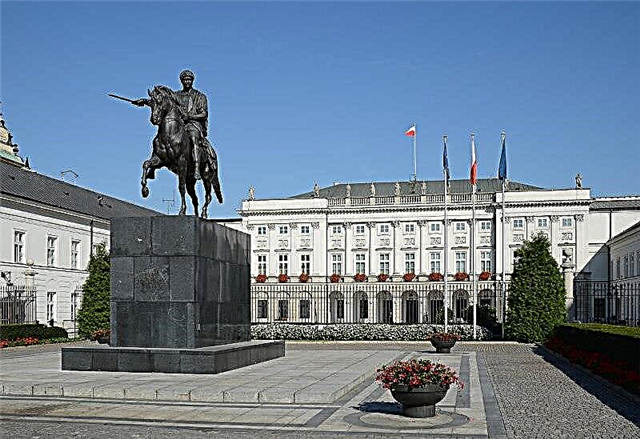In the southern wall of the ancient fortress there is a front entrance to the territory of the Kazan Kremlin. The elegant white tower stands near the oldest square in the city. All tourist buses stop here, and the newlyweds take pictures with pleasure. The slender silhouette of the four-storey building adorns many of Kazan's photo albums and travel guides.
Tower history
In 1552, after the Russian troops conquered the city, Tsar John IV the Terrible examined the old Bulgarian fortress and ordered to build new fortifications - larger and better than those destroyed. The sovereign chose three places, and in one day wooden churches appeared on them. According to the preserved legend, the church in honor of the Image of the Savior Not Made by Hands was erected on the place where the Russian Tsar stuck his battle banner.

General view of the Spasskaya Tower of the Kazan Kremlin
When times of peace came, the stone construction of the Kazan Kremlin proceeded slowly. John IV the Terrible was very unhappy with the delays. To speed things up, he sent to Kazan famous Pskov architects - Postnik Yakovlev, nicknamed "Barma" and Ivan Shiryaev. Together with them, 200 builders arrived in the city - "lomtsy" and "wallmen".
The Pskov masters pushed the boundaries of the fortifications 100 m away from the old Bulgar fortress, so the Church of the Savior was inside the building. In the 16th century, the new white limestone tower had two tiers. It was crowned with a wooden hipped roof with a guard tower, and on the sides there were galleries - "strelnitsy".

Initially, the passage through the tower had a T-shape. Then one arch was laid, and it became cranked. This was necessary to make it more difficult for the enemy to get into the fortress. The L-shaped passage did not allow the attackers to immediately deploy the ram. Enemies turned out to be sideways to the defenders of the Kremlin, and they could fire from bows at soldiers not covered by shields. At night, the passage to the Kremlin was closed by massive oak gates, next to which an iron lattice - "gersa" was lowered.
If we got to the Kazan Kremlin in the 16th century, then after the dark vaults of the Spassky Gate we would find ourselves in the Tsar's yard. The place where the Kazan voivode lived was located in the southeastern corner of the fortress. In the 19th century, it was rebuilt into the guardhouse of the military garrison of Kazan.

The square in front of the tower was also called "Spasskaya". The spacious territory was separated from the rest of Kazan by a deep moat, and one could get here only by a wooden bridge. From the end of the 18th century, the settlement and the Kazan Kremlin began to be connected by a solid white stone bridge.
Spasskaya Square played a special role in the life of the townspeople. Important royal decrees were announced there, public executions and solemn ceremonies were carried out. The Kazan shopping center was located here. Along the square there were stalls and stalls, where goods from all over Russia were brought. At the end of the 19th century, the stone bridge was dismantled, and the Kremlin moat was covered with earth.

Almost from the very foundation, a large alarm bell hung on the Spasskaya Tower. If the sentinel noticed a fire, he notified the residents of Kazan about it, and they rushed to help the victims of the fire.
In the middle of the 19th century, the passage in the tower was made through, but then the decision was changed. To the east of the building, a large arched passage was cut through the fortress wall. This entrance became the main entrance to the territory of the Kazan Kremlin.

The fate of the gateway temple
The Church of the Savior Not Made by Hands burned several times during the fires. In 1815, after another disaster, the temple was abandoned for two decades. In 1836, Nicholas I visited Kazan. The Emperor drew attention to the Spasskaya Tower and the crumbling temple and ordered to transfer it from the jurisdiction of the Kazan diocese to the military department. So the old church became the military temple of the Kazan garrison.

So that officers and lower ranks could pray, the temple building was reconstructed. A small passage between the church and the Spasskaya tower was removed, and both buildings were side by side. The church utensils completely burned out during the fire, so they were replaced with a new one. Fortunately, the old icon of the Savior Not Made by Hands was not damaged by the fire, so it was moved to the southern wall of the tower.
At the beginning of the last century, the diocesan architect F.N.Malinovsky developed a project, according to which a hipped-roof chapel of Christ the Savior was erected on the square. Pupils of Kazan schools and colleges believed that prayer in the chapel brings good luck in exams. Before the school trials, a line of those who wanted to light a candle and enlist heavenly support lined up at the entrance to a small church.

View of the Spasskaya Tower from the territory of the Kazan Kremlin
Then the power in the country changed, the chapel was destroyed, and the icon revered by believers was transferred to the Church of the Yaroslavl Miracle Workers. Then the gilded double-headed eagle was removed from the tower.
Today the old Church of the Savior Not Made by Hands adjoins the tower from the inside and is under restoration. On its northern facade, the decor of the 16th century has been preserved - blade arches and typical Pskov shoulder blades. The temple windows face the main street of the Kazan Kremlin.

Spasskaya Tower of the Kazan Kremlin in the night illumination
Architectural features
The old Spasskaya Tower is one of the well-preserved monuments of defense architecture of the 16th-17th centuries. It has four tiers and rises 46.6 m above the ground - to the height of a 16-storey building. The massive base, measuring 25 m by 25 m and 2.25-2.5 m thick, was built of white stone. Large hewn blocks are still visible under the lime coating. Preserved metal pins, on which hung oak gates, as well as grooves for a descending iron grate.

In the 17th century, the tower was completed with two octahedral brick tiers. The graceful decor - rumors, gulbis, window frames and the fly of the parapet indicate that Moscow craftsmen worked on the upper part of the tower.
The oldest bell of Kazan hangs in its place - on the open gallery of the fourth tier of the tower. It was cast over 400 years ago. A large golden star is visible at the very top of the hipped dome.

Clock
The first chimes appeared on the tower after reconstruction in the 18th century. The massive chiming movement weighed 3 tons and had an unusual design. The hands of the clock stood motionless, and the dial rotated around its axis. In the 1780s, a lighter watch with a traditional dial design was installed on the tower.
Today, the building is adorned with modern electronic-mechanical clocks with a classic design. Three watch movements weigh 20 kg each. The gray-bordered hands are made of lightweight aluminum. The hour hand has a length of 1.68 m, and the minute hand is 2.2 m. Earlier, the watchmaker was engaged in debugging the chimes, but in the age of high technologies this work is easily handled by a computer.

Chimes of the Spasskaya Tower of the Kazan Kremlin
When the Kremlin chimes begin their battle, the light and music show "Raspberry Chime" is turned on. Simultaneously with the sounds, red spotlights slowly flare up and go out, which paint the white walls of the tower in a bright crimson color. The original illumination is very beautiful during the day, but even more impressive at night.
Useful information for visitors
Popular light shows are regularly held on the white walls of the Spasskaya Tower. On the square, near the tower there are the buildings of the mayor's office and the city Duma of Kazan. The territory of the old John the Baptist monastery also goes here.

The National Museum is located in the former Gostiny Dvor, at 2 Kremlin Street. It contains more than 800 thousand exhibits that tell about the history and nature of Tatarstan. Tourists can see the richest collections of archaeological artifacts, weapons, numismatics, art objects, rare books, stuffed animals and birds.
In former times, on the fourth tier of the Spasskaya Tower, above the clock, there was an observation deck, from where an excellent view of the Kazan Kremlin, the high minarets of the Kul-Sharif mosque, the Pyramid entertainment complex, the Central Stadium and the Volga valley opened. Now the passage upstairs is closed for restoration. Rare sightseers are allowed to admire the panorama from the third tier of the tower, which is located at a height of 14 m.

How to get there
The high tower stands in the historic center of the city, to the north of May 1 Square. To get to the entrance to the Kremlin, tourists drive to the Kremlevskaya metro station, go out into the street through the northern lobby and walk past the monument to Musa Jalil on foot to the Spasskaya Tower.
Attraction rating:




